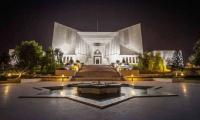In the past few weeks, the discovery of Daesh or IS-inspired cells in Karachi, Sialkot and Lahore has reignited the debate on whether IS has a formal presence in Pakistan or not.
The government’s ambivalence on the issue – mostly by denying IS’ existence in Pakistan – has allowed such cells to grow in different parts of the country. The growing IS footprint in Pakistan needs to be careful examined to analyse the potential threat it poses.
Since the rise of IS in June 2014 the global militant landscape has undergone a radical transformation. This transformation has affected different countries in different ways. Its impact on the Middle Eastern, North African and Western countries has been more noticeable than in states in South and Southeast Asia.
Five major trends underpin this transformation in jihadist-militancy at the global level. First, a generational shift has taken place with the emergence of a new breed of militants (fourth generation militants). In retrospect, the anti-Soviet Afghan jihadi groups represent the first generation. Al-Qaeda, the Afghan Taliban, sectarian and Kashmiri militant outfits are second generation militants. The post-9/11 breed of pro-Al-Qaeda groups are the third generation while IS and its affiliates embody the fourth generation.
Second, this generational shift has created new themes, motivations, trends and narratives. Third, IS has revolutionised the use of social media for dissemination of its extremist propaganda and online recruitment of would-be-radicals. The threat is now both online and offline, so the battlefield has expanded from the real world to the cyber world.
The fourth trend is that the epicentre of global jihad has shifted from Al-Qaeda Central in the Afghanistan-Pakistan region to IS in Syria and Iraq. This has increased the influence of Takfiri-Salafist ideology on jihadist organisations across the world. Five, IS’ ability to link local grievances with a global jihadist narrative has galvanised worldwide recruitment. Apparently, such rhetoric not only seems to address individual grievances in a collective setting but also provides a stronger sense of belonging and empowerment.
Against this backdrop, Pakistan needs to enhance its understanding of the changing extremist milieu and remodel its existing counterterrorism and counter-extremism polices in the light of new emerging realities. To do that, it is essential to deconstruct the approach and narrative of IS in the Pakistani context.
The emergence of IS in Pakistan has been in the form of isolated cell-structures in urban areas with roots in the middle class. The IS-inspired cells in Pakistan lack a formal organisational structure, which makes it harder to detect them. It also provides them with more operational independence to grow and plan lone-wolf style attacks. Additionally, the fluid nature of these cells makes them a big challenge for our law-enforcement agencies.
IS has combined the pan-Islamist narrative with an overt anti-Shia agenda, which equally appeals to the Islamist and sectarian militants in Pakistan. The defection of eight Jamaat-ud-Dawa militants to IS in Sialkot, and traces of cooperation between pro-IS militants and sectarian organisations in Pakistan highlight this fact. It is worth mentioning that, while IS has been overcritical of Al-Qaeda Central and the Afghan Taliban in its official English language magazine ‘Dabiq’, it has been silent on the Pakistani Taliban and Pakistani sectarian organisations.
In contrast to Al-Qaeda, which primarily focused on its enemies, IS attaches greater importance to providing governance and social services, in addition to protection, to those residing in IS-governed territories. The terror group’s success in carving out the so-called caliphate in parts of Syria and Iraq gives hope to would-be-radicals. It provides them with the unique opportunity to move to this so-called caliphate with their families.
This is enticing for new recruits because they can have a proper family life while waging jihad and contributing to the expansion of the caliphate. This is probably why we have witnessed more women and families from across the world moving to Syria and Iraq. The relocation of 20 women from Lahore to Syria with their daughters and children can be explained in this context.
So, this new generation of pro-IS radicals in Pakistan is tech-savvy, educated and urban, and from the middle and upper-middle classes. This new generation is overambitious and globally-oriented instead of subscribing to a narrow and parochial approach to jihadism. Rather than drawing inspiration from Al-Qaeda or the Taliban it looks towards IS for mentorship and legitimacy. This generation is unapologetically brutal and savage in its modus operandi. Moreover, it has a very strong sense of history and knows how to cherry-pick historical references from politics and religion for propaganda purposes. Also, it is very strategic and future-oriented in its approach.
Though law-enforcement agencies in Pakistan have efficiently arrested individuals linked with IS-inspired cells in the country, the scope of the responses has to go beyond law enforcement. At the outset, mainstream religious scholars in Pakistan should unequivocally denounce IS’ proclamation of caliphate.
At the heart of this response lies the question of who represents Islam. If IS-like extremist organisations are a fringe phenomenon in the Muslim world then the moderate and peaceful voices of mainstream Muslims should be brought forward by reclaiming the narrative from such outfits.
This will only happen when the legitimacy of the state is restored through improved governance and inclusive policies which address the questions that the Muslim youth have. The state has to make the younger generation a stakeholder in the political process by giving them a strong sense of belonging. IS preys upon vulnerabilities within our youth, and on weak state structures; it gets a chance to radicalise the youth when the state fails to provide them with a positive direction and purpose.
Pakistan will have to come up with youth, education and employment policies that own and mentor the country’s younger generation as an asset and future of the state. Unless that happens, IS-inspired cells will continue to emerge in one form or the other.
The writer is an associate researchfellow at the International Centre for Political Violence and Terrorism Research of the S Rajaratnam School of International Studies, Singapore.
Email: isabasit@ntu.edu.sg
Chinese philosopher Mencius prophesized 3000 years ago that state that does not employ worthy perishes
Over past two decades, rapid and often chaotic development has increasingly defined Islamabad's landscape
Donald Trump's entry into White House is going to be stormy
Most notable is dangerous surge in conflict at scale not seen since last world war
Coordinated attacks sent wave of insecurity across country, tarnished Pakistan's image globally
For now, IMF agreement provides essential cushion to help Pakistan return from the brink of Sri-Lanka-type default on...







